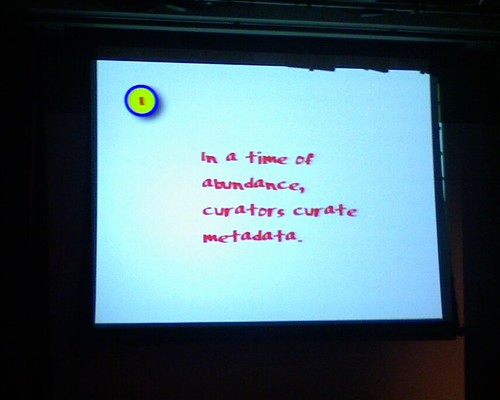This week's New York Times Magazine has a piece by Clive Thompson that explores issues around ambient awareness and privacy. Facebook, twitter, flickr, dopplr, and texting and blogging more generally. Is it narcissistic to broadcast your status using awareness tools? Are these tools to improve connectedness in a more mobile and global human ecology -- the ultimate tools for building and maintaining relationships?
This is the paradox of ambient awareness. Each little update — each individual bit of social information — is insignificant on its own, even supremely mundane. But taken together, over time, the little snippets coalesce into a surprisingly sophisticated portrait of your friends’ and family members’ lives, like thousands of dots making a pointillist painting. This was never before possible, because in the real world, no friend would bother to call you up and detail the sandwiches she was eating. The ambient information becomes like “a type of E.S.P.,” as Haley described it to me, an invisible dimension floating over everyday life.
...
And when they do socialize face to face, it feels oddly as if they’ve never actually been apart. They don’t need to ask, “So, what have you been up to?” because they already know. Instead, they’ll begin discussing something that one of the friends Twittered that afternoon, as if picking up a conversation in the middle.
An interesting section focuses on the so-called "Dunbar Number" -- just how many people can you be "friends" with, anyway? According to anthropologist Robin Dunbar, about 150. Can you max out on social connectedness? Not really, since many of one's ambient connections are weak ties, not close, intimate friends. But weak ties are just an important part of social and professional networks.
I find it useful to check in on my Facebook account and see the status newsfeeds of my friends and colleagues. I have also personally met all but a handful, and I believe that they are controlling their feeds and filtering what they write in their status that maintains their chosen levels of privacy. I keep my status updated. I blog, and I know and expect that people who have never met me read it. But is the ability to follow personal newsfeeds and tweets of people you will never know a creepy invasion of privacy, making it too easy to develop parasocial relationships? Or is it all just part of ubiquitous ambient awareness where participation is increasingly not optional?
I originally refused to blog or join Facebook because I thought it was vain to assume that anyone wanted to know what I was thinking or doing, and that I'd be giving up my privacy. OK, I have given up some of my privacy, but I've also made new connections I might never have otherwise, re-established relationships that had gone dormant, and built stronger ties with geographically disparate friends. While I'm not willing to give up my privacy for a free cup of coffee, I am willing to give up some privacy to to that.


